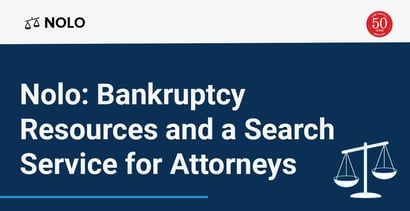
In a Nutshell: Sometimes, filing for bankruptcy can be the best course of action for people overwhelmed with debt and looking for a fresh start. But bankruptcy law is complex and it can be easy to get bad advice. Nolo is an authoritative resource for user-friendly information on bankruptcy and many other legal topics. Along with books and forms for legal self-help, it includes free legal articles and a search tool to help financially strapped individuals and families find qualified local bankruptcy attorneys.
For many individuals and families, struggling to get out of debt is nothing new, and they often seek help before the situation gets out of control.
Banks and credit unions may provide assistance, and budgeting can provide a path out of debt for many. But some consumers need much more relief.
In certain circumstances, all the assistance in the world won’t fix the problem. People sometimes become so financially overwhelmed that they can’t pay off their debt.
Unforeseen life events can play a significant role in those situations. Illness, job loss, and divorce can put people in holes so deep that declaring bankruptcy becomes the best option.
Contrary to what many believe, bankruptcy isn’t intended to punish people. The process is actually designed as a set of protections to help people get a fresh start. As with many legal issues, the process is complex, so it’s imperative for people to gain as much knowledge as possible and find an experienced attorney.

Nolo is a resource that can help. The company began in 1971 as a publishing house for do-it-yourself legal guides. Now it’s one of the leading legal websites for consumer-friendly education and resources.
Nolo’s collection of bankruptcy self-help books and articles are excellent sources on topics where expertise goes a long way. And through Nolo’s search service, it’s easy to find a trustworthy local law firm that can help.
“For more than 50 years, people have consulted Nolo to navigate legal issues,” said Cara O’Neill, Esq., Legal Editor, Bankruptcy, at Nolo.
Bankruptcy Lawyers Often Provide Free Consultations
Nolo is great for learning the ins and outs of bankruptcy. When it’s time to find a lawyer, enter your zip code and click “Search,” then review the results. You can toggle between viewing law firms and individual lawyers.

“Experience matters when hiring a bankruptcy lawyer,” O’Neill said. “The rules take time to learn, and it would be easy for a lawyer unfamiliar with the law to miss an important issue.”
Potential clients also often grapple with whether there’s an advantage in receiving local bankruptcy services.
For many clients, O’Neill said, the benefit gained by retaining a local firm outweighs the convenience of working remotely.
“A remote option shouldn’t be problematic if the lawyer can comply with current document signing and appearance requirements and is qualified to appear in the appropriate court,” she said. “However, clients with complicated cases would likely want to retain a local lawyer familiar with the bankruptcy court’s practices.”
Self-Help Available Through Clearly Written Resources
Nolo’s bankruptcy books include “How to File for Chapter 7 Bankruptcy,” which walks readers through the bankruptcy filing process and provides step-by-step instructions for completing the bankruptcy petition.
Nolo’s other bankruptcy books, “The New Bankruptcy” and “Chapter 13 Bankruptcy,” explain the unique benefits offered by Chapters 7 and 13, and serve as easy guides for navigating the bankruptcy process.
Among thousands of free online legal resources, Nolo has hundreds of bankruptcy articles readers can use to learn how bankruptcy works and what to expect after filing a bankruptcy case. All Nolo resources are free of legal jargon and written in plain English everyone can understand.
Armed with the knowledge from these resources, clients who secure bankruptcy services through Nolo’s search tool better understand the issues and the questions to ask during the initial consultation.

The essential issue is the difference between the two primary forms of bankruptcy filings. The Chapter 7 filing is generally for people who don’t own much property, have a limited income, and cannot repay their debts. In Chapter 7 bankruptcy, the bankruptcy trustee sells certain assets to repay creditors.
The Chapter 13 filing sets up a repayment plan based on the filer’s disposable income. In Chapter 13 scenarios, filers keep more of their property.
Whether a lawyer files a client’s bankruptcy case within days or months usually depends on how long it takes the client to provide financial documents and pay the lawyer’s retainer.
“A potential client should leave the initial meeting understanding how Chapters 7 and 13 work, which chapter would be best for the client, the costs involved, and the lawyer’s qualifications,” O’Neill said. “A general timeline covering the attorney’s filing process would also be helpful.”
Nolo: Authoritative Legal Advice Since 1971
No one seeks bankruptcy, but a bankruptcy filing negotiated by a qualified legal expert can work like a reset button. Filers start from square one and are in a position to acquire tools and skills to rebuild their credit and lead a more productive financial life.
Nolo has resources to guide people through many challenges associated with financial rebuilding. For example, debt management content occupies an entire section of the free portion of the site.
Information on starting and running a business includes issues such as forming a limited liability company, managing workers, and drafting contracts. There’s info on business employment issues, the gig economy, real estate, retirement planning, and accounting apps.
Nolo also looks at legal topics relevant to individuals and families, including parenting, divorce, child custody, immigration, and wills and trusts.
O’Neill said the average Chapter 7 filer receives a debt discharge in about four months. Most Chapter 13 cases take five years to complete, although some lower-income filers have the option of choosing a three-year plan.
Bankruptcy notations appear on a Chapter 7 filer’s credit report for 10 years. For Chapter 13 filings, they drop off after only seven years.
“However, the impact fades with time, and a responsible credit user’s score will improve much sooner,” O’Neill said.
Other challenges Chapter 7 filers face a year or two after bankruptcy include renting housing and opening bank accounts. But as filers strive to overcome challenges during the financial reset period, Nolo can be there every step of the way.
Indeed, Nolo’s long history and its content team’s extensive experience with legal writing ensure that Nolo’s content stands the test of time and remains current.




